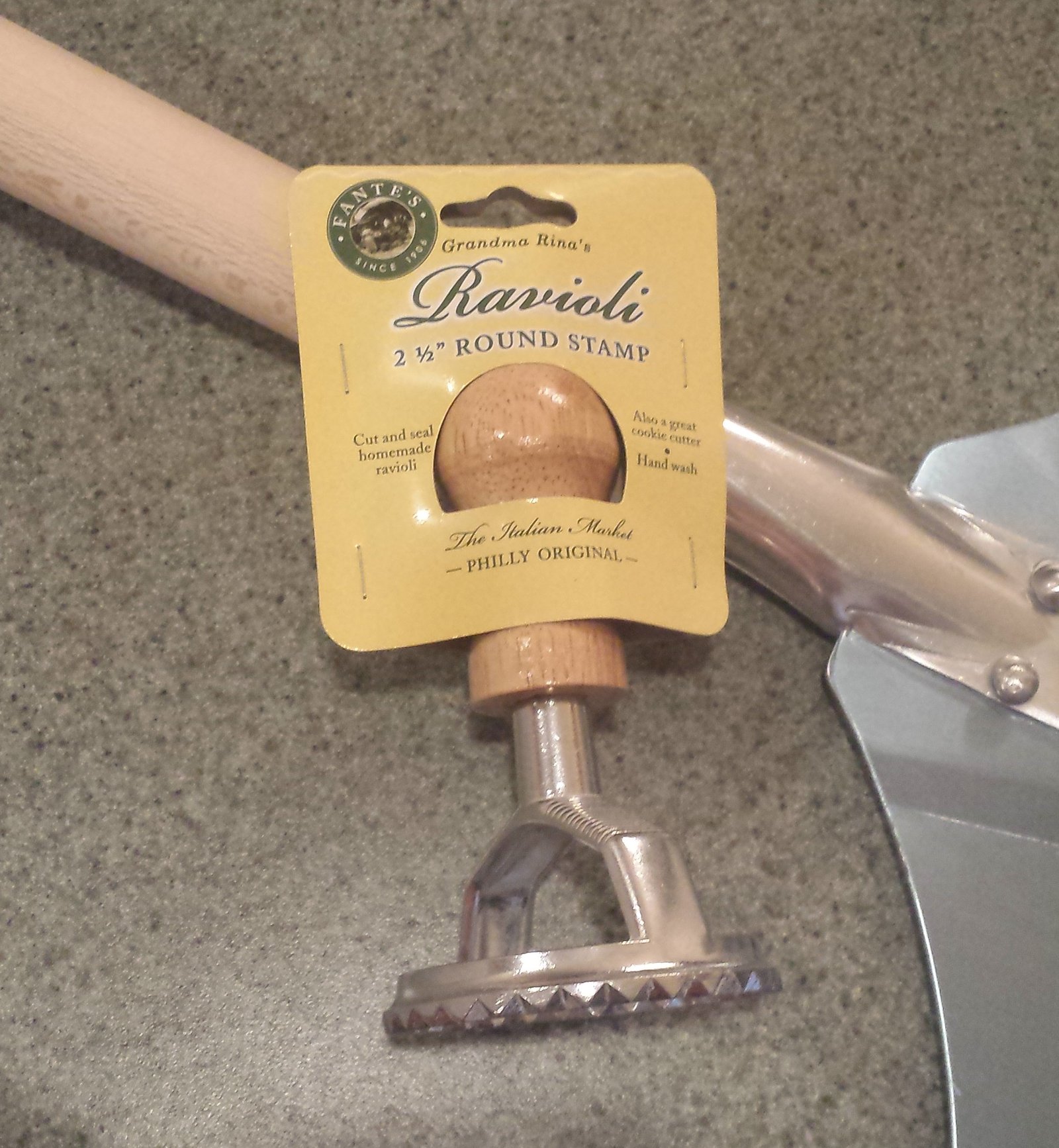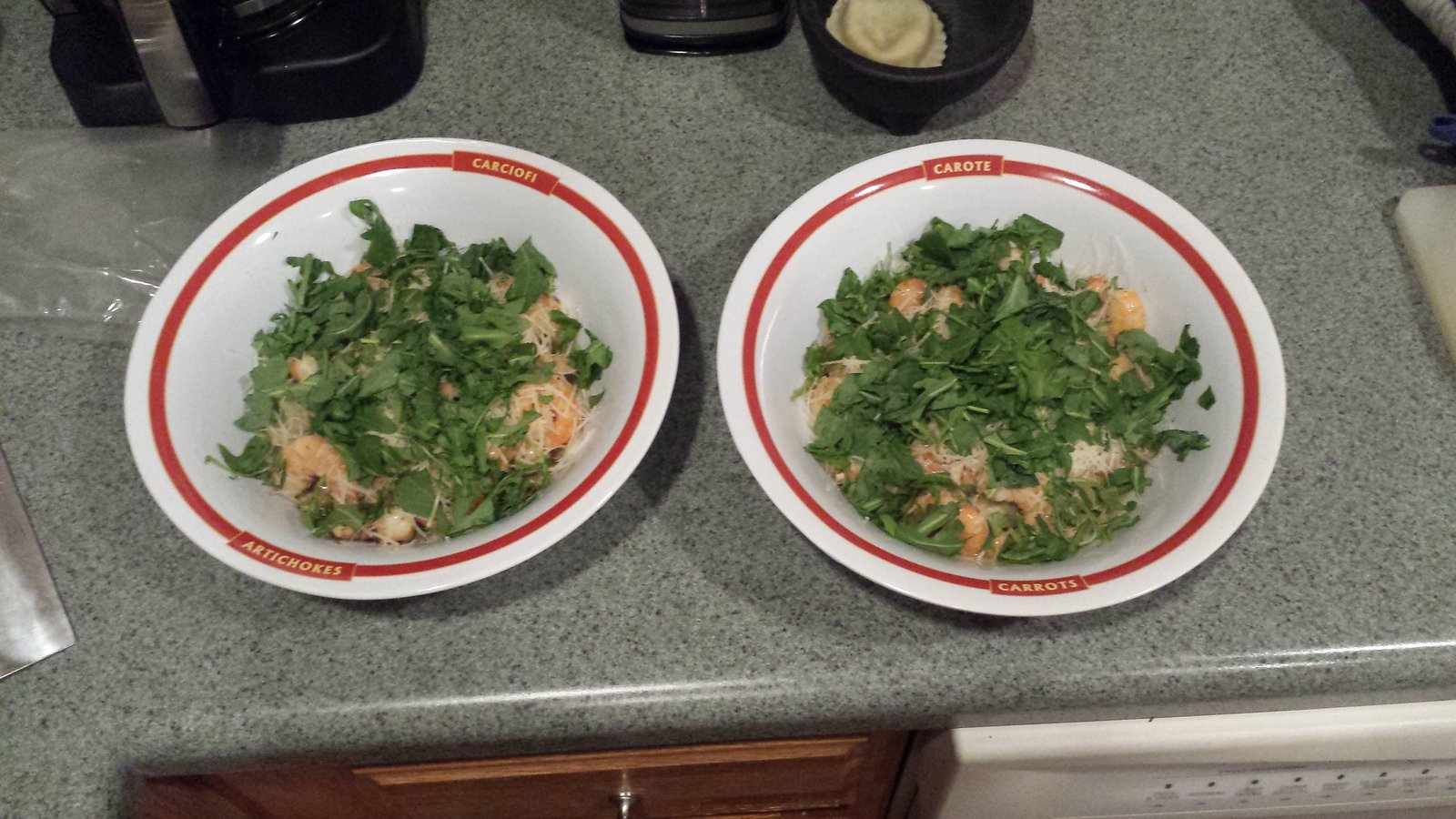This recipe is a little time consuming but it’s well worth it. It should serve 8 people as an appetizer or 4 people as a main dish.
This all started because I found a ravioli stamp at Ace Mart Restaurant Supply. So, we began looking for recipes online using what we already had in the kitchen. We had a pound of fresh Gulf Shrimp and quite a bit of arugula so I started scouring the internet for ideas. Most of the recipes for Shrimp Scampi Ravioli started off with prepackaged ravioli so those were out of the running. I finally found an Arugula & Goat Cheese Ravioli recipe on epicurious.com. This recipe became our inspiration for the ravioli we made.
There are multiple steps to this and we did it over the course of a rainy Saturday afternoon and evening. We would do one step, stop and watch some football, then do another step, watch some more football, etc. I think you could get through all, it start to finish, in about 2 to 2 1/2 hours.The first thing we did was peel and clean the shrimp. One of the recipes I read through suggested using the shrimp shells and tails to make a shrimp stock. So, I thought, why not. We peeled the full pound of shrimp and then cleaned them. We put the shells into a saucepan with some peppercorns and pinch of salt and then let them simmer for about 45 minutes. We put this aside to use the next time we make gumbo.
Once you have your shrimp ready, you have 3 main steps. First, prepare your pasta dough for the ravioli. Second, prepare the ravioli filling. Finally, prepare the sauce.
This recipe requires the pasta of about 1 1/2 cup to 2 cups of flour. You can use your favorite recipe or this one.
Instructions for the dough
- 2 cups of flour
- 2 large eggs
- 2 tablespoons olive oil
- pinch of salt
- extra lukewarm water
Make a mound of flour and then make a well in the middle of the flour. Put the eggs, olive oil and salt into the center of the well. Then beat the eggs with a fork and slowly start mixing it all together working a little flour into the mixture, a little at a time. Keep mixing until it is all incorporated. Use the water to give it more moisture as needed. Knead the dough for 5 to 10 minutes until it is smooth, silky and elastic.
I ended up needing quite a bit of water (a couple tablespoons) but I think it all has to do with the size of the eggs we use. Every time I make pasta I need extra water even when I follow the directions exactly as written. While I was writing this up, I found this website with some really good information on pasta called Serious Eats. I recommend checking it out to learn more about making fresh pasta. The Science of the Best Fresh Pasta
Once you’ve kneaded the pasta, roll it into a ball and tightly wrap it in plastic wrap. Let it rest for at least 30 minutes.
Instructions for the filling
- 2 tablespoons unsalted butter
- 2 teaspoons of finely chopped garlic (or more if you like it extra garlicky)
- 1 teaspoon of salt
- 1 teaspoon of pepper
- 2 cups of trimmed arugula
- 1 cup of mustard greens (optional but adds good flavor)
- 1 teaspoon of finely grated fresh lemon zest
- 1/2 cup of soft mild goat cheese
- 1/2 cup of cottage cheese
- 1/4 cup grated Parmesan cheese
Put the butter in a skillet and heat it over medium heat until the foam subsides. Then add the garlic, salt and pepper and cook, stirring occasionally, until the garlic is golden, about 1 to 2 minutes. Add the arugula, mustard greens and lemon zest. Cook this down until the arugula and greens are wilted, turning it with tongs. It should take about 2 to 4 minutes. Remove from heat and transfer this mixture into a fine mesh sieve and strain it over a bowl to get out the excess liquid. Set the liquid aside to add to the sauce mixture. Once the mixture is cool enough to touch, finely chop and mix with the goat cheese, cottage cheese and parmesan cheese.
Instructions for the sauce
- 1/2 stick of unsalted butter (1/4 cup)
- 2 tablespoon finely chopped garlic
- 1/2 teaspoon of black pepper
- 1/4 teaspoon of salt
- 2 teaspoons of lemon juice
- 1/4 cup extra virgin olive oil
- 1 pound peeled and cleaned medium to large shrimp
- 1/2 cup chopped arugula
Heat the butter in a 12-inch skillet over moderate heat until the foam subsides. Then, add the garlic, pepper and salt. Stir frequently until the garlic starts to golden, which should be about 2 to 4 minutes. Add the lemon juice, oil and the reserved liquid that you set aside while making the stuffing. Continue cooking for an additional minute then remove from heat. You’ll add the arugula as a garnish over the ravioli on the plate.
Making and Cooking the ravioli
After your dough is rested, divide it into 8 equal parts. Cover 7 of them with a kitchen cloth while you work with the first one. Roll this one in a pasta roller. Set the pasta roller on the widest setting and feed a rectangle through the roller. Fold it in half and feed it through again. Repeat this 6 or 7 additional times. Then, turn the dial on the roller to the next narrower setting and feed the dough through the rollers without folding. Continue to roll the pasta through the roller making the space between the rollers narrower each time until you get to the second to narrowest setting. In my roller, I started on setting #1 which is the widest and eventually got to setting #5. Our roller has 6 setting but #6 would be way too thin and you’d risk the past tearing once it was filled.

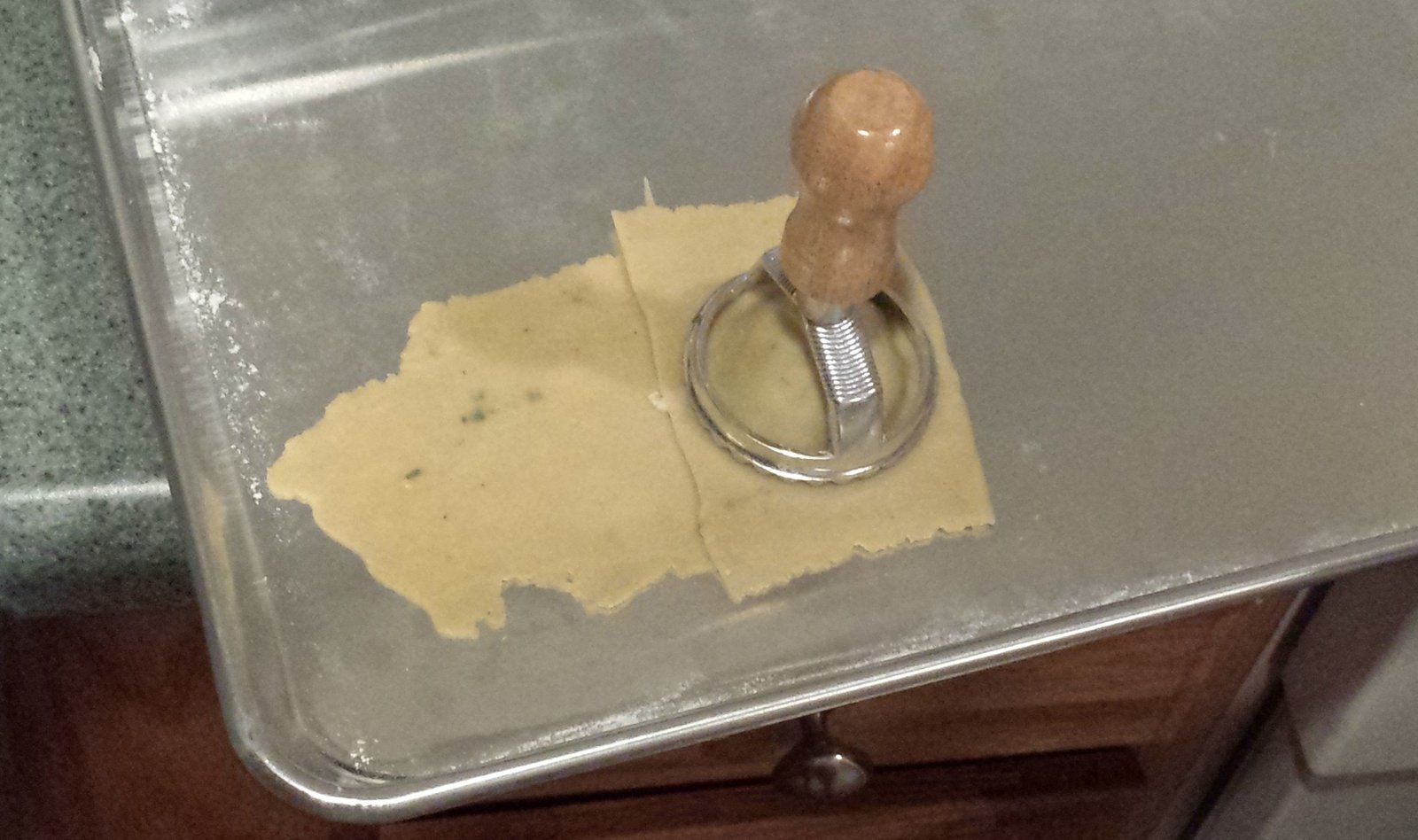
Put the sheet of dough on a lightly floured work surface, We used a cookie sheet. The long side should be nearest you. Most recipes have you put the filling into rounded teaspoon sized mounds down the center of one-half of the sheet. My new ravioli stamp was too large for this so we had to make them one at a time by putting a mound of filling on the pasta about 4 inches from the end and folding the end over the mound and then using the stamp to cut the pasta. This took forever but they did look good. As we cut away the excess pasta we started combining it to create a new ball of pasta that we used to roll out a new sheet. If you don’t have a stamp, just put your mounds about 1 1/2 inches apart down the center of one-half of the sheet. Then fold the sheet down the middle over the mounds of filling. Press down firmly but gently to remove the air. Any air pockets will increase the chance that the ravioli will break during cooking. Cut the pasta between the mounds into squares. You can use a fork to seal the edges (and it makes it look good). As you make them, place the cut ravioli onto a lightly floured kitchen towel. We intentionally let ours sit for about 20 minutes to sort of start drying and it seems to help because we didn’t have a single ravioli break during cooking.
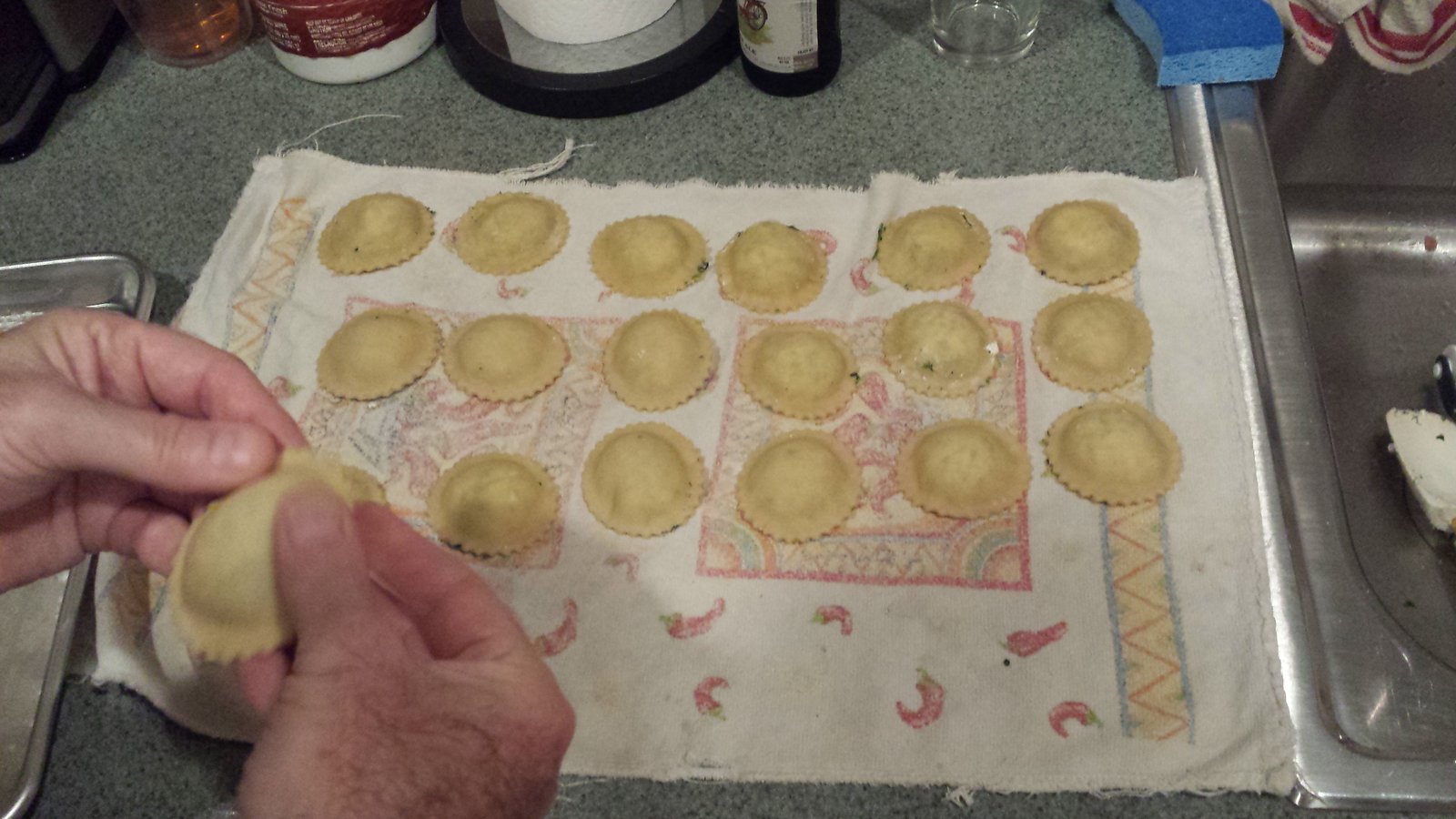
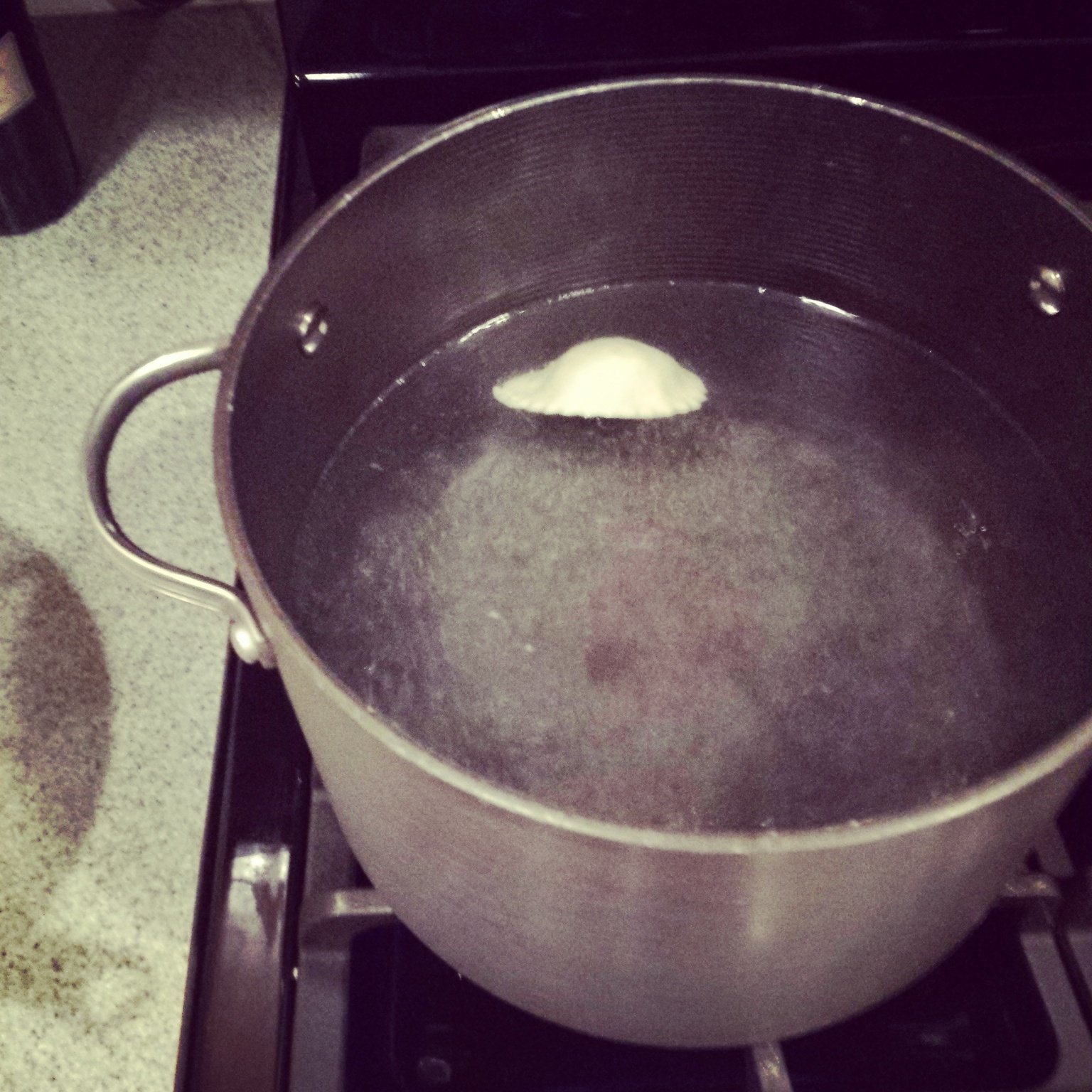
To cook the ravioli, bring a large pot of salted water to a boil over high heat, then reduce heat to a gentle boil. If this is your first time to cook ravioli, take one ravioli as a sample and gently place it in the water. Check the pasta after 3 minutes to test for how done it is. In one minute increments, keep cooking the ravioli until it is done and to your liking. We figured out that 5 to 6 minutes was the correct amount of time for our ravioli. Now, gently place half the ravioli into the boiling water and gently stir to separate the ravioli. Keep the water at a gentle boil until the pasta is tender. To remove from water, use a slotted spoon and drain over the water then transfer them to a clean tray or plate. We found that removing them one at a time is best. Then cook the remaining half of the ravioli.

Now that the ravioli are ready, go back to your sauce and reheat it to a light simmer and add the shrimp. Saute the shrimp in the sauce until the shrimp are bright pink and ready, it should be really quick and just take 2 to 4 minutes (depending on the size of your shrimp).
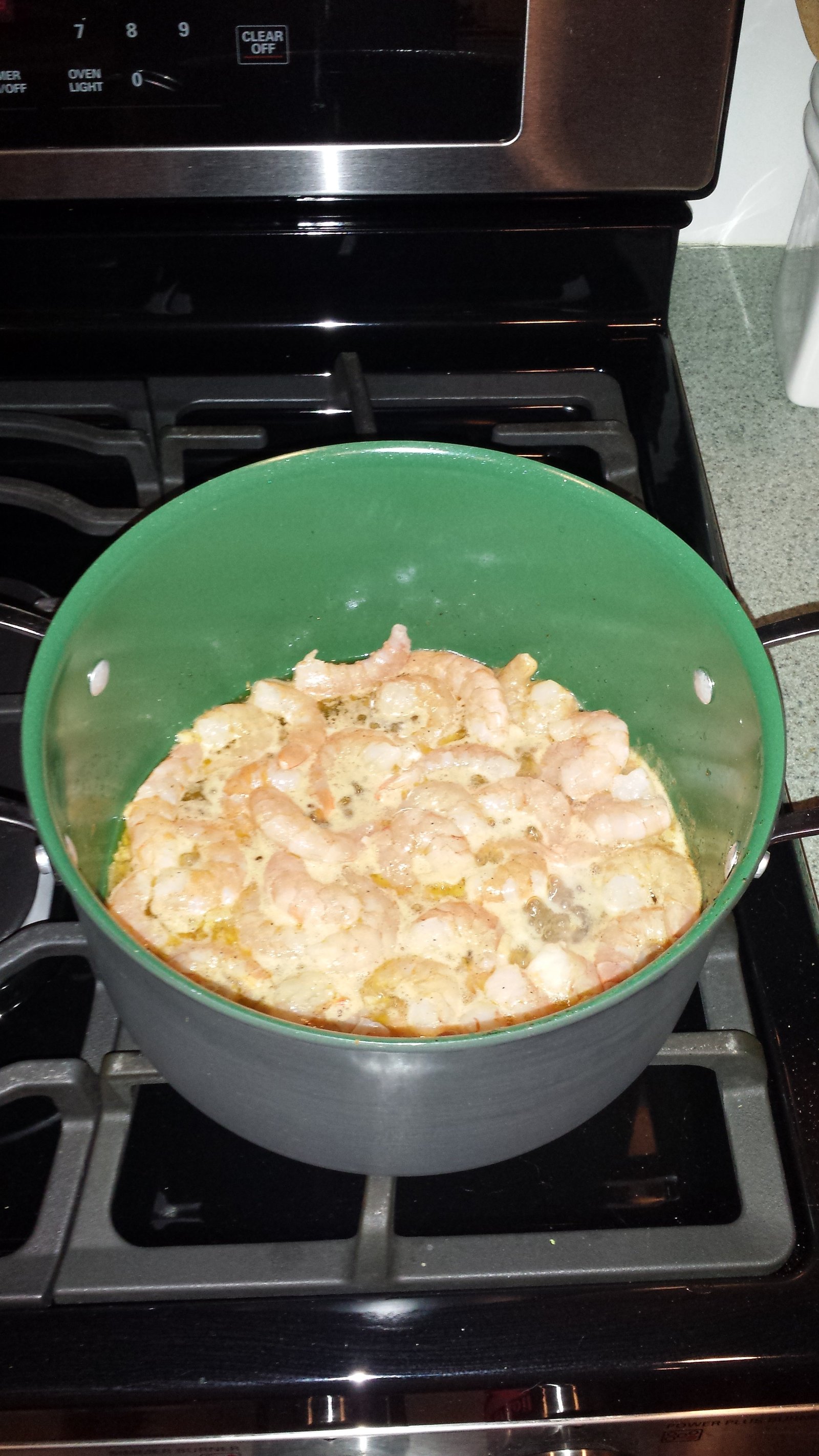
Once the ravioli are cooked and the shrimp has been sauteed in the sauce, divide them among your plates then cover with the sauce and add the arugula over the pasta. You can get enough for 5 or 6 people, depending on how many ravioli you want to put on each plate. It was just the two of us so we put about 7 into one bowl and 7 into another bowl. This was our main course and we served it with a salad on the side.

